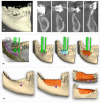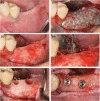Vertical and horizontal ridge augmentation using customized CAD/CAM titanium mesh with versus without resorbable membranes. A randomized clinical trial
- PMID: 34551168
- PMCID: PMC9293224
- DOI: 10.1111/clr.13841
Vertical and horizontal ridge augmentation using customized CAD/CAM titanium mesh with versus without resorbable membranes. A randomized clinical trial
Abstract
Objectives: The aim was to evaluate the role of resorbable membranes applied over customized titanium meshes related to soft tissue healing and bone regeneration after vertical/horizontal bone augmentation.
Materials and methods: Thirty patients with partial edentulism of the maxilla/mandible, with vertical/horizontal reabsorption of the alveolar bone, and needing implant-supported restorations, were randomly divided into two groups: Group A was treated using only custom-made meshes (Mesh-) and Group B using custom-made meshes with cross-linked collagen membranes (Mesh+). Data collection included surgical/technical and healing complications, "pseudo-periosteum" thickness, bone density, planned bone volume (PBV), regenerated bone volume (RBV), regeneration rate (RR), vertical bone gain (VBG), and implant survival in regenerated areas. Statistical analysis was performed between the two study groups using a significance level of α = .05.
Results: Regarding the healing complications, the noninferiority analysis proved to be inconclusive, despite the better results of group Mesh+ (13%) compared to group Mesh- (33%): estimated value -1.13 CI-95% from -0.44 to 0.17. Superiority approach confirmed the absence of significant differences (p = .39). RBV was 803.27 mm3 and 843.13 mm3 , respectively, and higher RR was observed in group Mesh+ (82.3%) compared to Mesh- (74.3%), although this value did not reach a statistical significance (p = .44). All 30 patients completed the study, receiving 71 implants; 68 out of them were clinically stable and in function.
Conclusion: The results showed that customized meshes alone do not appear to be inferior to customized meshes covered by cross-linked collagen membranes in terms of healing complication rates and regeneration rates, although superior results were observed in group Mesh+compared to group Mesh- for all variables.
Keywords: alveolar ridge augmentation; collagen membrane; healing complication; osseointegrated implants; titanium mesh.
© 2021 The Authors. Clinical Oral Implants Research published by John Wiley & Sons Ltd.
Figures







Similar articles
-
Complication, vertical bone gain, volumetric changes after vertical ridge augmentation using customized reinforced PTFE mesh or Ti-mesh. A non-inferiority randomized clinical trial.Clin Oral Implants Res. 2024 Dec;35(12):1616-1639. doi: 10.1111/clr.14350. Epub 2024 Aug 23. Clin Oral Implants Res. 2024. PMID: 39180274 Free PMC article. Clinical Trial.
-
Clinical and volumetric outcomes after vertical ridge augmentation using computer-aided-design/computer-aided manufacturing (CAD/CAM) customized titanium meshes: a pilot study.BMC Oral Health. 2020 Aug 5;20(1):219. doi: 10.1186/s12903-020-01205-4. BMC Oral Health. 2020. PMID: 32758217 Free PMC article.
-
Histological and histomorphometric analysis of bone tissue using customized titanium meshes with or without resorbable membranes: A randomized clinical trial.Clin Oral Implants Res. 2024 Jan;35(1):114-130. doi: 10.1111/clr.14202. Epub 2023 Nov 15. Clin Oral Implants Res. 2024. PMID: 37966057 Clinical Trial.
-
Bone augmentation using titanium mesh: A systematic review and meta-analysis.Int J Oral Implantol (Berl). 2024 Sep 16;17(3):251-269. Int J Oral Implantol (Berl). 2024. PMID: 39283219
-
The Outcomes of Vertical Alveolar Bone Augmentation by Guided Bone Regeneration with Titanium Mesh: A Systematic Review.J Contemp Dent Pract. 2022 Dec 1;23(12):1280-1288. doi: 10.5005/jp-journals-10024-3444. J Contemp Dent Pract. 2022. PMID: 37125527
Cited by
-
Clinical feasibility evaluation of a digital workflow of prosthetically oriented onlay bone grafting for horizontal alveolar augmentation: a prospective pilot study.BMC Oral Health. 2023 Oct 30;23(1):824. doi: 10.1186/s12903-023-03556-0. BMC Oral Health. 2023. PMID: 37904141 Free PMC article.
-
Advanced Techniques for Bone Restoration and Immediate Loading after Implant Failure: A Case Report.Healthcare (Basel). 2023 May 31;11(11):1608. doi: 10.3390/healthcare11111608. Healthcare (Basel). 2023. PMID: 37297748 Free PMC article.
-
Alveolar bone regeneration using a 3D-printed patient-specific resorbable scaffold for dental implant placement: A case report.Clin Oral Implants Res. 2024 Dec;35(12):1655-1668. doi: 10.1111/clr.14340. Epub 2024 Aug 7. Clin Oral Implants Res. 2024. PMID: 39109582 Free PMC article.
-
Customized Bone Regeneration-A Retrospective Clinical Follow-Up Study of the Aesthetic Outcome.Clin Oral Implants Res. 2025 Jun;36(6):759-770. doi: 10.1111/clr.14425. Epub 2025 Mar 7. Clin Oral Implants Res. 2025. PMID: 40055546 Free PMC article.
-
Specially designed and CAD/CAM manufactured allogeneic bone blocks using for augmentation of a highly atrophic maxilla show a stable base for an all-on-six treatment concept: a case report.Maxillofac Plast Reconstr Surg. 2022 May 24;44(1):21. doi: 10.1186/s40902-022-00351-9. Maxillofac Plast Reconstr Surg. 2022. PMID: 35608728 Free PMC article.
References
-
- Alayan, J. , & Ivanovski, S. (2018). A prospective controlled trial comparing xenograft/autogenous bone and collagen‐stabilized xenograft for maxillary sinus augmentation‐complications, patient‐reported outcomes and volumetric analysis. Clinical Oral Implants Research, 29(2), 248–262. 10.1111/clr.13107 - DOI - PubMed
-
- Bornstein, M. M. , Al‐Nawas, B. , Kuchler, U. , & Tahmaseb, A. (2014). Consensus statements and recommended clinical procedures regarding contemporary surgical and radiographic techniques in implant dentistry. The International Journal of Oral & Maxillofacial Implants, 29S, 78–82. 10.11607/jomi.2013.g1 - DOI - PubMed
Publication types
MeSH terms
Substances
LinkOut - more resources
Full Text Sources
Miscellaneous

